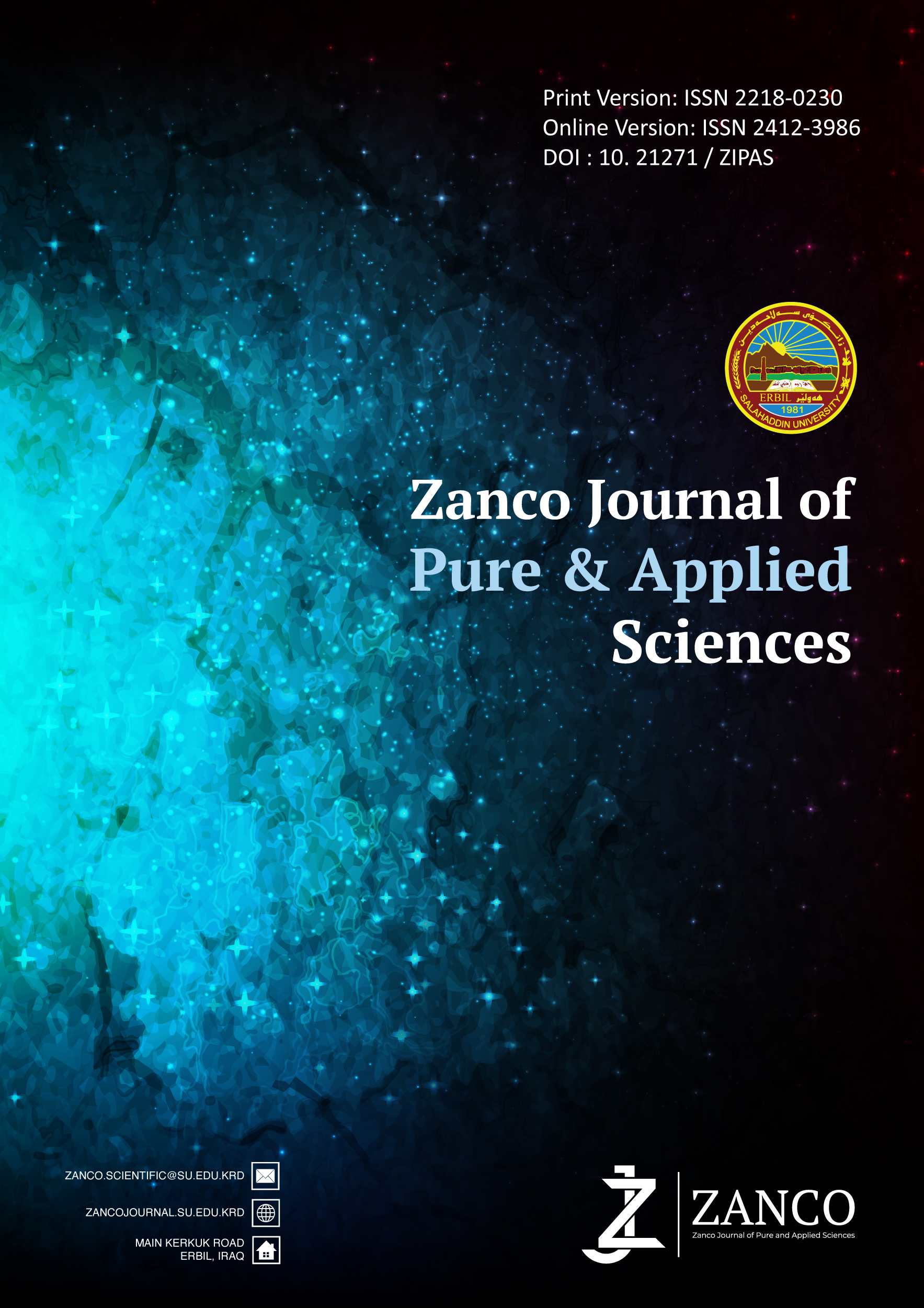Efficacy of five plant extracts against Black bean aphid, Aphis fabae Scopoli (Hemiptera: Aphididae)
DOI:
https://doi.org/10.21271/ZJPAS.36.6.8Keywords:
Aphis fabae, Plant extracts, insecticidal activity, LC50, exposure period.Abstract
The efficacy of five selected plant extracts: Basil (Ocimum basilicum), Cloves (Syzygium aromaticum), Tarragon (Artemisia dracunculus), Mint (Mentha sp.), and Dill (Anethum graveolens) against Aphis fabae on both nymph and adult stages was evaluated under laboratory conditions. Four concentrations were used 10000, 20000, 50000, and 100000 ppm. The results showed that the maximum mortality percentage of the nymph stage of A. fabae was achieved by basil, tarragon, and clove aqueous extracts at concentrations of 10000 ppm after 72 hours of treatment. Conversely, basil, clove, and tarragon extracts recorded the highest mortality rate of adults under the same experimental conditions. The positive control (Acetamiprid 20%) produced the highest mortality rate after 72 hours of exposure while using distilled water as the negative control resulted in a minimal mortality rate. The LC50 values indicate that basil extract exhibited the highest toxicity for nymphs at 1664.177 ppm after 72 hours, while for adults, tarragon extract was the most toxic at 720.553 ppm at 72 hours.
References
ABBOTT, W. S. 1925. A method of computing the effectiveness of an insecticide. J. econ. Entomol, 18, 265-267.
ABDEL-RAHMAN, R. S., ISMAIL, I. A. E., MOHAMED, T. A., HEGAZY, M. E. F. & ABDELSHAFEEK, K. A. 2019. Laboratory and field evaluation of certain wild plant extracts against Aphis fabae Scop.(Homoptera: Aphididae) and its predators. Bulletin of the National Research Centre, 43, 1-5.
ABDULHAY, H. S. 2012. Insecticidal activity of aqueous and methanol extracts of apricot Prunus armeniaca L. kernels in the control of Tribolium confusum Duval (Coleoptera: Tenebrionidae). Al-Mustansiriyah Journal of Science, 23, 7-18.
AHMED, K. S. & MAJEED, M. Z. 2016. Integrated pest management tactics and predatory coccinellids: A review.
ATANASOVA, D., GANCHEV, D. & NENOV, N. 2018. Efficacy of some plant essential oils against cotton aphid, Aphis gossypii Glover (Hemiptera: Aphididae) under laboratory conditions. Mayfeb Journal of Agricultural Science, 1, 10-16.
BINIAŚ, B., GOSPODAREK, J. & RUSIN, M. 2017. Effect of water extract from mint on selected crop pests feeding and survival. Journal of Ecological engineering, 18.
BLACKMAN, R., EASTOP, V., VAN EMDEN, H. & HARRINGTON, R. 2007. Aphids as crop pests. Taxonomic Issues; van Emden, HF, Harrington, R., Eds, 1-29.
CHAHAL, K., KUMAR, A., BHARDWAJ, U. & KAUR, R. 2017. Chemistry and biological activities of Anethum graveolens L.(dill) essential oil: A review. Journal of Pharmacognosy and Phytochemistry, 6, 295-306.
CHERMENSKAYA, T. D., STEPANYCHEVA, E. A., SHCHENIKOVA, A. V., SAVELIEVA, E. I. & CHAKAEVA, A. S. 2012. Insecticidal effects of Ungernia severtzovii bulb extracts against the grain aphid Schizaphis graminum (Rondani). Industrial Crops and Products, 36, 122-126.
DARWISH, A. 2019. The Predation Efficiency And Feeding Preference of Coccinella Septempunctata L. and Coccinella Undecimpunctata L.(Coleoptera: Coccinellidae) On Some Prey Species. Menoufia Journal of Plant Protection, 4, 7-16.
EL-WAKEIL, N., GAAFAR, N., SALLAM, A. & VOLKMAR, C. 2013. Side effects of insecticides on natural enemies and possibility of their integration in plant protection strategies. Agricultural and biological sciences “insecticides—development of safer and more effective technologies”. Intech, Rijeka, Croatia, 1-54.
GOSPODAREK, J., ENDALAMEW, A., WORSDALE, M. & PAŚMIONKA, I. B. 2022. Effects of Artemisia dracunculus L. Water Extracts on Selected Pests and Aphid Predator Coccinella septempunctata L. Agronomy, 12, 788.
HANSEN, L. M., LORENTSEN, L. & BOELT, B. 2008. How to reduce the incidence of black bean aphids (Aphis fabae Scop.) attacking organic growing field beans (Vicia faba L.) by growing partially resistant bean varieties and by intercropping field beans with cereals. Acta Agriculturae Scandinavica Section B–Soil and Plant Science, 58, 359-364.
HARO-GONZÁLEZ, J. N., CASTILLO-HERRERA, G. A., MARTÍNEZ-VELÁZQUEZ, M. & ESPINOSA-ANDREWS, H. 2021. Clove essential oil (Syzygium aromaticum L. Myrtaceae): Extraction, chemical composition, food applications, and essential bioactivity for human health. Molecules, 26, 6387.
IRIÉ-N’GUESSAN, G., CHAMPY, P., KOUAKOU-SIRANSY, G., KOFFI, A., KABLAN, B. J. & LEBLAIS, V. 2011. Tracheal relaxation of five Ivorian anti-asthmatic plants: role of epithelium and K+ channels in the effect of the aqueous-alcoholic extract of Dichrostachys cinerea root bark. Journal of Ethnopharmacology, 138, 432-438.
KERGUNTEUIL, A., DUGRAVOT, S., DANNER, H., VAN DAM, N. M. & CORTESERO, A. M. 2015. Characterizing volatiles and attractiveness of five brassicaceous plants with potential for a ‘push-pull’strategy toward the cabbage root fly, Delia radicum. Journal of chemical ecology, 41, 330-339.
KHIDR, S. K. & KHALIL, S. M. 2024. Efficacy of Six Aqueous Plant Extracts and Three Commercial Entomopathogenic Fungi Against the Corn Ground Beetle Larvae, Zabrus tenebrioides Under Laboratory Conditions. Arab Journal of Plant Protection, 42.
LENGAI, G. M., MUTHOMI, J. W. & MBEGA, E. R. 2020. Phytochemical activity and role of botanical pesticides in pest management for sustainable agricultural crop production. Scientific African, 7, e00239.
MAMADALIEVA, N. Z., HUSSAIN, H. & XIAO, J. 2020. Recent advances in genus Mentha: Phytochemistry, antimicrobial effects, and food applications. Food Frontiers, 1, 435-458.
MARWAT, S. K., KHAN, M. S., GHULAM, S., ANWAR, N., MUSTAFA, G. & USMAN, K. 2011. Phytochemical constituents and pharmacological activities of sweet Basil-Ocimum basilicum L.(Lamiaceae). Asian Journal of Chemistry, 23, 3773.
MESQUITA, L. S. S. D., LUZ, T. R. S. A., MESQUITA, J. W. C. D., COUTINHO, D. F., AMARAL, F. M. M. D., RIBEIRO, M. N. D. S. & MALIK, S. 2019. Exploring the anticancer properties of essential oils from family Lamiaceae. Food Reviews International, 35, 105-131.
PINTO, M. L. & AGRÒ, A. 2021. Effects of essential oils of Origanum vulgare L.(Fam. Labiatee), Pelargonium odoratissimum L.(Fam. Geraniaceae) and Syzygium aromaticum L.(Fam. Mirtaceae) on mortality of Aphis gossypii Glover (Homoptera: Aphidiidae) in laboratory. INTERNATIONAL JOURNAL OF ENTOMOLOGY RESEARCH, 6, 301-306.
SADEGHI, A., VAN DAMME, E. J. & SMAGGHE, G. 2009. Evaluation of the susceptibility of the pea aphid, Acyrthosiphon pisum, to a selection of novel biorational insecticides using an artificial diet. Journal of Insect science, 9, 65.
SAYED, S. M., ALOTAIBI, S. S., GABER, N. & ELARRNAOUTY, S.-A. 2020. Evaluation of five medicinal plant extracts on Aphis craccivora (Hemiptera: Aphididae) and its predator, Chrysoperla carnea (Neuroptera: Chrysopidae) under laboratory conditions. Insects, 11, 398.
YAROU, B. B., BAWIN, T., ASSOGBA-KOMLAN, F., MENSAH, A. & FRANCIS, F. 2021. Repellent Effect of Basil (Ocimum spp) on Pea Aphid (Acyrthosiphon pisum Harris) and Potential Use in Crops. Proceedings
YAROU, B. B., BOKONON-GANTA, A. H., VERHEGGEN, F. J., LOGNAY, G. C. & FRANCIS, F. 2020. Aphid behavior on Amaranthus hybridus L.(Amaranthaceae) associated with Ocimum spp.(Lamiaceae) as repellent plants. Agronomy, 10, 736.
YOUSUF, I., BUHROO, A. A. & NISA, G. 2021. Repellent activities of some plant extracts against rose aphid, Macrosiphum rosae (Hemiptera: Aphididae). Munis Entomol. Zool, 16, 1045-1055.
Downloads
Published
How to Cite
Issue
Section
License
Copyright (c) 2024 Gona Sirwan Sharif

This work is licensed under a Creative Commons Attribution 4.0 International License.














